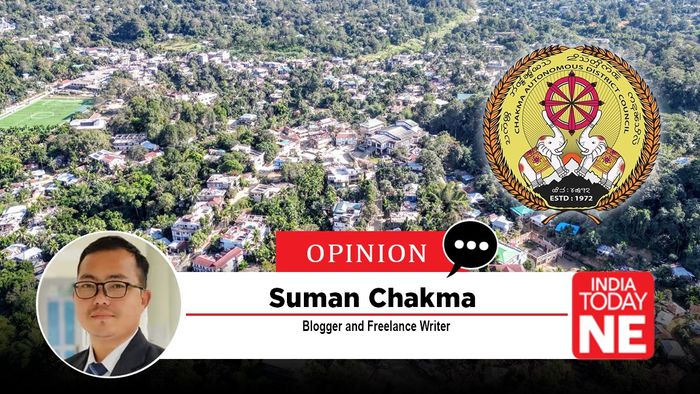Kamalanagar: An emerging urban hub of the Chakma Autonomous District Council
Kamalanagar, historically known as Chawngte, has been a sub-division within Mizoram’s Lawngtlai district since April 1, 1972,following the trifurcation of the Pawi-Lakher Regional Council into the Lai (Pawi), the Mara (Lakher) and the Chakma Autonomous District Council for the irrespective communities. Though, it is one of the proposed districts in Mizoram.

- Aug 31, 2025,
- Updated Aug 31, 2025, 2:51 PM IST
Kamalanagar, historically known as Chawngte, has been a sub-division within Mizoram’s Lawngtlai district since April 1, 1972,following the trifurcation of the Pawi-Lakher Regional Council into the Lai (Pawi), the Mara (Lakher) and the Chakma Autonomous District Council for the irrespective communities. Though, it is one of the proposed districts in Mizoram.
Perched along the banks of the Tuichawng River, Kamalanagar serves as the administrative headquarters of the Chakma Autonomous District Council (CADC) in Mizoram’s Lawngtlai district, has evolved as an emerging urban hub. Over recent years, the cluster of 13 villages within a 2.5-kilometer radiushas witnessed significant demographic growth and socio-economic development, prompting formal proposals for declaration as a Census Town to ensure sustainable urban planning and enhanced public delivery services to meet the aspirations of the growing population.
Following the 2011 Census, the Chakma Autonomous District Council, under the powers vested by the Village Council Act of 2003, has actively restructured administrative boundaries by bifurcating several villages into separate village councils, optimizing local governance in the Kamalanagar town area.
According to the 2023 Village Population Register, these 13 constituent village councils collectively acommodate around 17,807 residents, with a male population of approximately 8,790 and about 80% engaged in non-agricultural activities, fulfilling one of the key criteria for urban classification. Furthermore, the area’s population density is estimated at 908 persons per square kilometer, surpassing the minimum threshold of 400 persons per square kilometer stipulated by Census guidelines. This demographic profile firmly positions Kamalanagar as a thriving and increasingly urbanized center within the CADC jurisdiction.
The town's strategic importance is underscored by its role as the socio-economic and administrative nucleus of the Chakma community. Kamalanagar hosts 33 departmental offices of the CADC, including key government agencies, a police station, post offices, treasury, educational institutions such as Government Kamalanagar College, the sole government college offering undergraduate courses, and essential financial institutions like the State Bank of India and Mizoram Rural Bank. The presence of these establishments highlights Kamalanagar’s function as both a governance center and a commercial hub where agricultural produce from remote areas is traded in accessible markets, facilitating economic growth.
The formal proposal for Census Town status, submitted by the then Chief Executive Member of CADC, Shri Rasik Mohan Chakma, received significant administrative attention at multiple levels. The Deputy Commissioner of Lawngtlai forwarded the proposal to the Government of Mizoram’s General Administration Department in September 2024, emphasizing the need for planned urban development to prevent haphazard growth. Official recognition as a Census Town would unlock access to various development schemes and increase infrastructural funding from both central and state governments, thereby ensuring sustainable urban growth.
Nevertheless, the path to formal recognition entails fulfilling census requirements, which presents certain challenges. Notably, some villages within Kamalanagar’s proposed boundaries—specifically Kamalanagar V, Kamalanagar VI, and Arotinagar—were established after the 2011 Census, leading to gaps in available data on workforce composition and population density for these areas. Moreover, theCensus guidelines for 2027 mandate a strict freeze on administrative boundaries by December 31, 2025, pressing for timely resolution of these issues.
Correspondence from the Directorate of Census Operations, Mizoram, dated August 13, 2025, clarifies that Kamalanagar remains a conglomeration of 13 distinct villages, each holding seperate MDDS code as per the 2011 Census. This fragmented administrative status currently precludes the combined entity from qualifying as a Census Town under prevailing norms. However, the Directorate noted that if the State Government officially notifies Kamalanagar as a Census Town, this new status can be incorporated into the upcoming Census, presenting a viable path for official urban recognition dependent on state-level decisions.
Comparatively, Mizoram has seen successful upgrades of other localities to urban or district headquarters status. Tlabung in Lunglei district, recognized as a Census Town since 2011, serves as a commercial center with established urban governance, while Hnahthial, declared a full district headquarters in 2019, operates administratively despite its largely rural character. Kamalanagar’s proposed Census Town status is distinctive due to its larger population, higher density, and its pivotal role as the administrative and socio-economic heart of the Chakma Autonomous District Council, highlighting its growing significance in the region’s urban geography.
In conclusion, Kamalanagar stands at a critical juncture in its development trajectory. Formal recognition as a Census Town is a timely and strategic move to institutionalize its urban character, promote planned infrastructure development, and enhance the residents’ quality of life. Through coordinated efforts among local authorities, state government, and census authorities, Kamalanagar is poised to solidify its status as a key urban hub in Mizoram’s evolving landscape, reflecting both its demographic vitality and administrative significance.